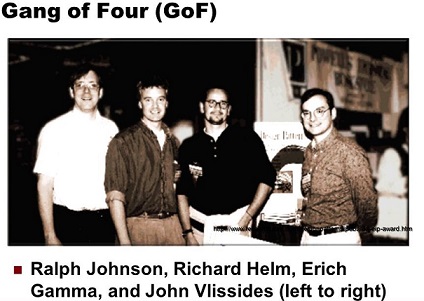Full Stack Development Internship Program
- 29k Enrolled Learners
- Weekend/Weekday
- Live Class
Design patterns in JavaScript are the advanced object-oriented solutions to the commonly recurring software problems. Patterns are the reusable designs and interactions of objects. Each pattern has a name and becomes part of a vocabulary when discussing complex design solutions.
Software Design Pattern can be defined as a software template or a description to solve a problem that occurs in multiple instances while designing a Software Application or a Software Framework.
Now, let us discuss the Gang of Four (GoF)
The 23 Gang of Four (GoF) patterns are usually considered the foundation for all the other patterns.

The Gang of Four (GoF) from Design Patterns:
Elements of Reusable Object-Oriented Software, Addison-Wesley Professional Computing Series, by Erich Gamma, Richard Helm, Ralph Jhonson, and John Vlissides. These 23 GoF patterns are generally considered the foundation for all other patterns. They are categorized into three groups: Creational, Structural and Behavioural.
There are basically three different types of Design Patterns in JavaScript. They are as follows:

Abstract Factory: This creates an instance with several families of classes. This provides an interface for creating families which are related or dependent objects without any specification of their concrete classes.
Builder: This separated object construction from its representation. Also separates the construction of a complex object from its representation so that the exactly same construction process can be created with different representations.
Factory Method: This creates an instance for several derived classes. Also defines an interface for creating an object, but it lets subclass decide which class to instantiate. This also has a Factory Method which lets a class defer instantiation to subclasses.
Prototype: It is a fully initialized instance which can be copied or cloned. Specifically, the kind of objects to create using a prototypical instance, create new objects by copying this prototype.
Singleton: It is fully initialised instances to be copied or to be cloned. It is of specific kind of objects to create using a prototypical instance and create new objects by copying this prototype.

Adapter: It matches interfaces of the different classes. Also converts the interface of a class into another interface except the one having the client. The adapter also lets classes work together that could have not been otherwise due to the incompatibility interfaces.
Bridge: It separates an object’s interface from its implementation. Decoupling an abstract from its implementation so that the two can vary independently.
Composite: A tree structure is of simple and composite objects, composed objects into tree structures to represent part-whole hierarchies. Composite lets the clients treat individual objects and compositions of objects uniformly.
Decorator: Adds the responsibilities to objects dynamically. Attaches the additional responsibilities to an object dynamically. Decorators also provide a flexible alternative to subclassing for extending functionalities.
Facade: A single class that represents an entire subsystem and provides a unifies interface to a set of interfaces in a system. Façade defines a higher-level interface which makes the subsystem easier to use.
Flyweight: A fine-grained instance used for efficient sharing to support large numbers of fine-grained objects efficiently. A flyweight is a shared object that may be used in the multiple numbers of contexts simultaneously. The flyweight also acts as an independent object in each context – It’s indistinguishable from an instance of the objects that are not shared.
Proxy: It is an object representing another object. It provides a surrogate or a placeholder object to control the access to it.

Chain of Responsibility: It is a way of passing a request between a chain of objects. It avoids the coupling with the sender and sends a request to its receiver by giving more than one object a chance to handle the request. The receiving objects are chained and passed the request along the chain until an object handles it.
Command: It encapsulates a command request as an object. Encapsulated request as an object, therefore letting you parameterize clients with different request, queue or log requests, and support the undoable operations.
Interpreter: It is a way to include language elements in a program. Given a language, define a representation for its grammar along with an interpreter that uses the representation to interpret sentences in the language.
Iterator: The sequential access of the elements of a collection provides a way to access the elements of an aggregate object sequentially without exposing its underlying representation.
Mediator: It defines simplifies communication between classes. Define an object that encapsulates how a set of objects interact. Mediator promotes the loose coupling by keeping objects from referring to each other explicitly, and it lets you vary their interaction independently.
Memento: It captures and restores the object’s internal state. It does not violate encapsulation, capture and externalize an object’s internal state so that the object can be restored to this state later.
Observer: It is a way of notifying the change to a number of classes. It defines a one-to-many dependency between objects so that when one object changes state, all its depending’s are notified and updated automatically.
State: It alters the behaviour of an object when its state changes. Allows an object to alter its behaviour when it is internal state changes. The object will appear to change its class.
Strategy: It encapsulates an algorithm inside a class and defines a family algorithm, encapsulate each one, and make then interchangeable. Strategy lets the algorithm vary independently from the clients that use it.
Template: Defer the exact steps of an algorithm to a subclass. It defines the skeleton of an algorithm in an operation, deferring some important steps to subclasses. Template Method lets us create a subclass redefine certain steps of an algorithm without changing the algorithm’s structure.
Visitor: It defines a new operation to a class without change. Represent an operation to be performed on the elements of an object structure. Visitor lets you define a new operation without changing the classes of the elements on which it operates.
With this, we come to the end of this article. I hope you have understood the Design Patterns in JavaScript, their types, importance and their implementation.
Now that you have understood the basics of Design Patterns in JavaScript, check out the Java training by Edureka, a trusted online learning company with a network of more than 250,000 satisfied learners spread across the globe. Edureka’s Java J2EE and SOA training and certification course is designed for students and professionals who want to be a Java Developer. The course is designed to give you a head start into Java programming and train you for both core and advanced Java concepts along with various Java frameworks like Hibernate & Spring.
Got a question for us? Mention it in the comments section of this “Design Patterns in JavaScript” blog and we will get back to you as soon as possible.
 Thank you for registering Join Edureka Meetup community for 100+ Free Webinars each month JOIN MEETUP GROUP
Thank you for registering Join Edureka Meetup community for 100+ Free Webinars each month JOIN MEETUP GROUPedureka.co